5 ways to check if the hard drive is SSD or HDD on Windows computer
Compared to Hard Disk Drive - HDD, Solid State Drive (SSD) is much faster and more efficient. SSDs are often used to store operating systems, helping to reduce startup and application running times.
1. How to check SSD or HDD with Task Manager
Task Manager is a system management tool that allows users to view/manage processes and applications running on the Windows operating system. It includes information about Windows processes as well as other services.
IT professionals can use this information to detect and identify unusual software, which may be malware or unauthorized software. Task Manager allows administrators to terminate processes or applications, adjust processing priorities, and customize process relationships for optimal performance.
Additionally, Task Manager is a system monitoring tool. It displays basic performance information and graphical data about CPU, swap-file and memory usage. In newer versions of Task Manager, it displays detailed information about disk and network usage. IT professionals can use Task Manager to test and quickly identify performance and stability issues before implementing troubleshooting or security tools.
Besides, you can see if the hard drive on your computer is SSD or HDD using Task Manager as follows:
Step 1: Open Task Manager by right-clicking on the task bar > selecting Task Manager
Step 2: If the screen you get looks like the following, click More details in the lower left corner to switch to full view.

Step 3: Select the Performance tab.
Step 4: Select the Disk section , look down at the bottom right, find Type , you will know the type of computer drive you are using: SSD or HDD.
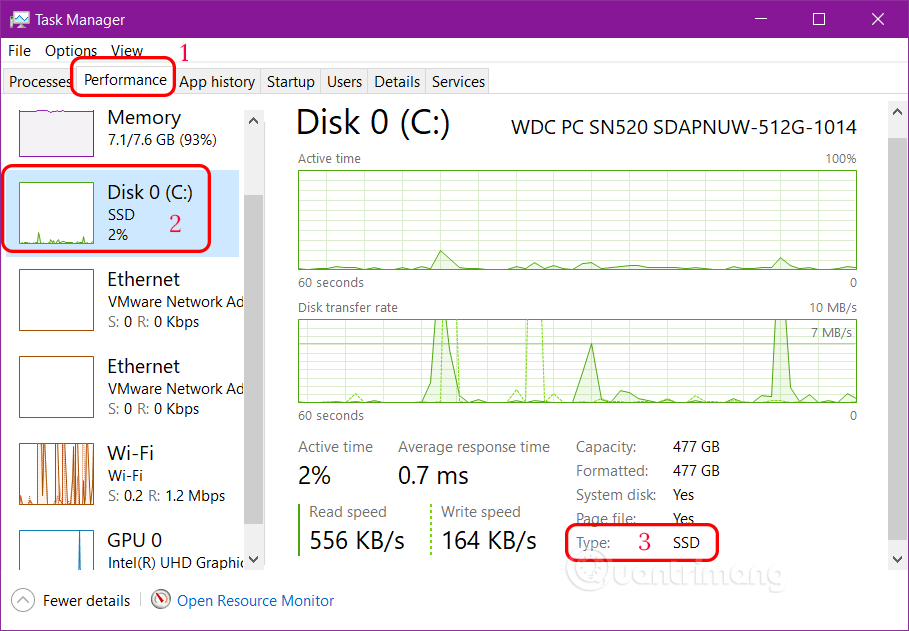
2. Check if the hard drive is SSD or HDD using PowerShell
With PowerShell, you only need one command to check the SSD hard drive on your computer, see if the computer is using an SSD, HDD or both, as follows:
Step 1: Open PowerShell with admin rights: enter PowerShell in the search box > right-click on the result and select Run as Administrator.
Step 2: In the PowerShell window, enter the following command and press Enter :
Get-PhysicalDiskStep 3: In the command results, look for Media Type, you will see the type of hard drive you are using. As the results below show, the machine is using both SSD and HDD .

3. Check the SSD hard drive in use using Defragment and Optimize Drive
The Defragmentation tool in Windows 10 is often used to defragment drives. As part of Windows 10, the Defragment tool provides a lot of information about all physical drives on the system. It's possible to use that information to find out if you have SDD.
Step 1: First, enter Defragment and Optimize Drive in the search box and open it.
Note: You can also access the Defragment and Optimize Drive tool in the following way:
- .
- Navigate to the This PC folder .
- Right-click the drive you want and select Properties from the context menu.
- Switch to the Tools tab and click the Optimize button under Optimize and defragment drive .
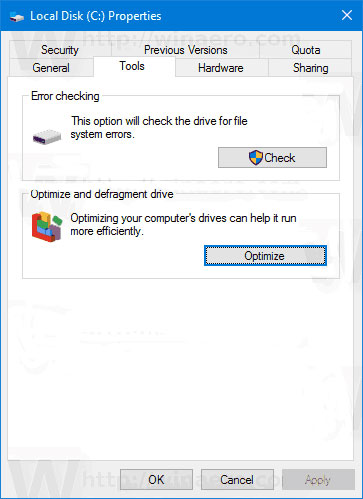
Step 2: As soon as the Defragment tool is opened, you will see all your partitions on the main screen. If you look at the Media Type section, you will know whether your hard drive is SSD or HDD. If there is an SSD, the tool will list it as Solid State Drive . A typical mechanical hard drive will be listed as a Hard Disk Drive .
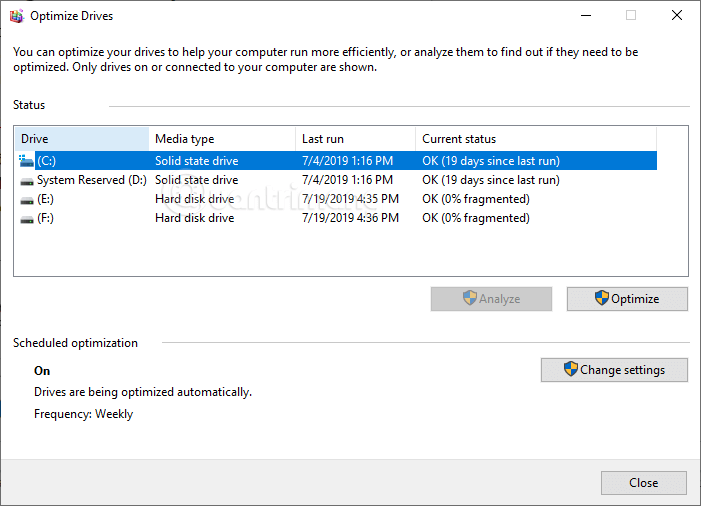
In the image above, there are two drives: SSD for Windows installation and HDD for regular storage, the Defragment and Optimize Drives tool is showing both drives.
Once you've verified whether you have an SSD or not, just close the window. Don't worry about fragmentation. Windows will automatically defragment the drive weekly or monthly.
4. Use Speccy (third-party software)
Speccy is a simple, free third-party tool that displays a lot of information related to all system hardware such as CPU, hard drive, motherboard, peripherals, network cards, etc.
Step 1: Download Speccy here. Once downloaded, install and open Speccy using the shortcut or Start menu.
Step 2: After opening Speccy, select Storage on the left panel. On the control panel, the right side of Speccy will list all the hard drives. If there is an SSD in the system, Speccy will add the '(SSD)' tag next to the hard drive name. As can be seen in the image below, the SSD has this tag and the HDD does not.
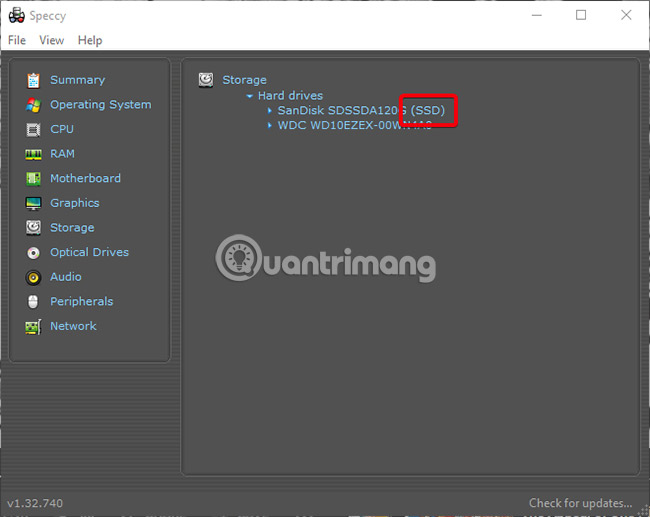
5. Use Windows System Information
The Windows System Information tool is a great tool for resolving hardware conflicts as well as getting basic information about each component of your computer. The Windows System Information tool is a built-in Windows tool, available in all Windows versions including Windows XP, Windows Vista, Windows 7, Windows 8, and Windows 10.
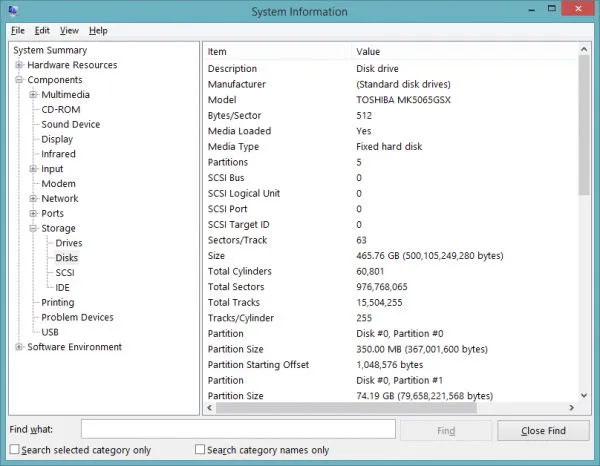
Step 1: To open the System Information tool , go to Run > msinfo32 .
Step 2: A new window will open. You need to expand Components > Storage > Disks from the menu tree on the left.
Step 3: The right-hand panel will provide you with detailed information about each hard drive attached to the system. The information doesn't have any titles so you'll need to learn the details about each hard drive carefully.
All work is completed!
Above are 5 ways to check if your computer is using an SSD or HDD. If you want to know more information about your computer system, try checking your computer configuration with the article that TipsMake guided. You can also check the hard drive status, view the hard drive temperature to have a more reasonable way to use the hard drive.
If there is another method to know whether the hard drive you are using is SSD or HDD, please share with us and other readers in the comments section below.
Good luck!
You should read it
- 3 How to check the working status of the hard drive
- 8 effective ways to check your hard drive to periodically check the health of your hard drive
- Know about bad sectors on your hard drive
- How to identify hard drive failure, hard drive failure, bad hard drive on Windows
- Check and fix hard drive errors with chkdsk on Windows
- How to check the standard hard drive of GPT or MBR
- How to check and diagnose computer hard drive health
- 3 ways to check the health of the hard drive on a Windows computer
May be interested
- 6 ways to check SDD or HDD hard drive in detail and quickly!
 how to check if the hard drive is ssd or hdd? check out 9 quick and simple ways to check if the hard drive is ssd or hdd with hacom!
how to check if the hard drive is ssd or hdd? check out 9 quick and simple ways to check if the hard drive is ssd or hdd with hacom! - Causes and ways to fix external hard drive slow on Windows 10
 when plugging an external hard drive into a computer and finding it slower than before? whether your computer is infected with a virus or a certain setting in windows 10 makes everything slow or maybe just a simple problem like a broken cable. this article will find out the cause and offer a way to fix the external hard drive slow on windows 10.
when plugging an external hard drive into a computer and finding it slower than before? whether your computer is infected with a virus or a certain setting in windows 10 makes everything slow or maybe just a simple problem like a broken cable. this article will find out the cause and offer a way to fix the external hard drive slow on windows 10. - How to check the drive in Windows 10
 microsoft hard drive repair and scanning tool, check disk (chkdsk) has been around for over 30 years and is still useful today. users running microsoft's latest operating system can still use this tool to check the drive. this article will guide you to check the drive on windows 10.
microsoft hard drive repair and scanning tool, check disk (chkdsk) has been around for over 30 years and is still useful today. users running microsoft's latest operating system can still use this tool to check the drive. this article will guide you to check the drive on windows 10. - Computer hard drive is fast, why?
 a hard drive is an important component of a computer, all user data such as windows operating system or personal data is stored on the hard drive and they are always accessed regularly. typically, the average life of a hard drive on a desktop computer is about 6 years. however, there are cases that only 1-2 years of use is broken. so what causes the computer hard drive to crash?
a hard drive is an important component of a computer, all user data such as windows operating system or personal data is stored on the hard drive and they are always accessed regularly. typically, the average life of a hard drive on a desktop computer is about 6 years. however, there are cases that only 1-2 years of use is broken. so what causes the computer hard drive to crash? - How to check the standard hard drive of GPT or MBR
 gpt or mbr are both hard drive standards that define how to import or export data, organize and partition drives. so your computer is using standard gpt or mbr hard drive?
gpt or mbr are both hard drive standards that define how to import or export data, organize and partition drives. so your computer is using standard gpt or mbr hard drive? - How to check and diagnose computer hard drive health
 all of the hard drives in our computers use smart (self-monitoring, analysis, and reporting technology) systems to evaluate endurance and determine if they are working properly. .
all of the hard drives in our computers use smart (self-monitoring, analysis, and reporting technology) systems to evaluate endurance and determine if they are working properly. . - Top 3 software to check the hard drive for the best bad
 top 3 software to check the hard drive for the best bad. hard drive bad sectors are horrible errors that any computer user does not want to make. when bad sectors on the hard drive, the high probability that we have to replace the drive, the data in the bad partition is also difficult to recover data.
top 3 software to check the hard drive for the best bad. hard drive bad sectors are horrible errors that any computer user does not want to make. when bad sectors on the hard drive, the high probability that we have to replace the drive, the data in the bad partition is also difficult to recover data. - Instructions for 5 ways to fix the error of not recognizing the removable hard drive on Windows
 portable hard drives help expand the storage space outside the computer. but when connecting the portable hard drive to the computer, your windows cannot recognize the portable hard drive. guide you 5 ways to fix this error.
portable hard drives help expand the storage space outside the computer. but when connecting the portable hard drive to the computer, your windows cannot recognize the portable hard drive. guide you 5 ways to fix this error. - When and how to defragment hard drives on Windows 10?
 over time, the files on your hard drive will be fragmented, and your computer will gradually slow down because you have to check the files in many places on the hard drive. to make your computer run faster and smoother, you can use the tools available on windows 10 to defragment files.
over time, the files on your hard drive will be fragmented, and your computer will gradually slow down because you have to check the files in many places on the hard drive. to make your computer run faster and smoother, you can use the tools available on windows 10 to defragment files. - 6 software to monitor Windows 10 hard drive activity
 too many simultaneous operations on the hard drive can slow down the system and deplete laptop battery, so sometimes you should monitor hard drive activity.
too many simultaneous operations on the hard drive can slow down the system and deplete laptop battery, so sometimes you should monitor hard drive activity.










 What to do when you lose one AirPod?
What to do when you lose one AirPod? Why does a mouse need more than two buttons?
Why does a mouse need more than two buttons? 7 features that make Galaxy Z Flip 6 worth buying
7 features that make Galaxy Z Flip 6 worth buying 6 fastest and most accurate ways to check your video card
6 fastest and most accurate ways to check your video card How to improve the sound quality of your speakers
How to improve the sound quality of your speakers The 5 best SSDs for Steam Deck
The 5 best SSDs for Steam Deck